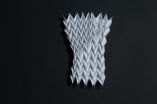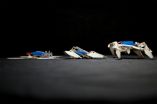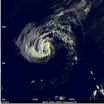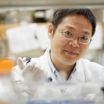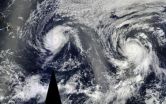(Press-News.org) ITHACA, N.Y. – Embracing the pleats, creases and tucks of the Japanese art of decorative paper folding, Cornell University researchers are uncovering how origami principles could lead to exotic materials, soft robots and even tiny transformers.
Publishing online in the journal Science Aug. 8, an interdisciplinary team led by Cornell's Itai Cohen, associate professor of physics, and graduate student Jesse Silverberg have discovered how to use a well-known origami folding pattern called the Miura-ori to control fundamental physical properties of any thin sheet of material.
Video, photos, study: https://cornell.box.com/origami
The Miura-ori, which consists of repeatedly folded parallelograms, can change the stiffness of a sheet of paper – and, by extension, any material from which it's folded – based only on the crease pattern. Moreover, by altering the pattern and introducing defects, they showed how to tune its stiffness, creating a material in which physical properties can be programmed.
Silverberg, an origami enthusiast since second grade, got the idea for studying the Miura-ori during a physics meeting, when co-author Chris Santangelo of the University of Massachusetts, Amherst, noticed its unusual properties. Most known materials bulge when squeezed, like a sponge. But the Miura-ori contracts when squeezed. "This is desirable for engineering all sorts of devices you wouldn't be able to make otherwise," Silverberg said.
The team, which also includes Arthur Evans and Ryan Hayward of UMass Amherst; and Thomas Hull of Western New England University, used desktop models – many hand-folded by Silverberg – and computational analysis by Evans to identify principles that could be applied to the design of metamaterials.
Metamaterials are generated by a repeating pattern of smaller subunits to engineer exotic, non-natural properties on larger scales. The Miura-ori itself can be considered a mechanical metamaterial because its stiffness can be controlled by the specific fold angles of the parallelograms, Silverberg said.
But unlike other metamaterials with fixed properties, "pop-through defects," which are made by changing crease directions, can be introduced at arbitrary locations within the sheet to change its stiffness.
Using numerical simulations, Evans and Santangelo calculated the effect that such a pop-through defect has on the Miura-ori. They showed that it instantly makes the entire sheet stiffer, and that their effect is additive. A pattern of pop-through defects behaves like a computer program: While a string of 0's and 1's tells a computer what to do, a configuration of pop-through defects controls the "hardware" and tells the Miura-ori how to respond to external forces. They also found that a neighboring pop-through defect with opposite orientation can cancel out the first defect. This effect is similar to what in atomic systems would be called a "vacancy" – where an atom is removed from a crystal lattice.
"We're looking at an origami structure and using a language developed for understanding the mechanical properties of atomic crystals to talk about what we see here," Silverberg said. "Our work brings together origami, metamaterials, programmable matter, crystallography and more. It's totally bizarre and unique to have so many of these ideas intersecting at the same time."
The dream? Atomic-scale machines programmed based on folding patterns that could snap into place and perform mechanical functions.
"You can imagine a folded sheet of some material and popping in defects to make a stiff shield, or somehow deploying an object and giving it a rigid backbone," Cohen said. "You can think of it as appendages that can be locked in place or a useful tool whose properties can be set once it has been deployed. In that way, it's kind of like the transformers, where robots fold themselves up but unfurl, locked, into human form."
Cohen added: "It is amazing that there are so many hidden scientific research problems buried in just a simple sheet of paper."
INFORMATION:
The research, "Using Origami Design Principles to Fold Reprogrammable Mechanical Metamaterials," was supported by the National Science Foundation and conducted in collaboration with theoretical physicists and polymer engineers at University of Massachusetts, Amherst, and mathematicians at Western New England University.
Cohen's group will present the research at the Sixth International Meeting on Origami in Science, Mathematics and Education, Aug. 10-13 in Tokyo.
Cornell University has television, ISDN and dedicated Skype/Google+ Hangout studios available for media interviews.
Origami could lead to exotic materials, tiny transformers
2014-08-07
ELSE PRESS RELEASES FROM THIS DATE:
Step closer to birth of the sun
2014-08-07
Researchers are a step closer to understanding the birth of the sun.
Published in Science, the team led by Dr Maria Lugaro and Professor Alexander Heger, from Monash University, have investigated the solar system's prehistoric phase and the events that led to the birth of the sun.
Dr Lugaro, from the Monash Centre for Astrophysics, said the team used radioactivity to date the last time that heavy elements such as gold, silver, platinum, lead and rare-earth elements were added to the solar system matter by the stars that produced them.
"Using heavy radioactive nuclei ...
Finding the genetic culprits that drive antibiotic resistance
2014-08-07
Researchers have developed a powerful new tool to identify genetic changes in disease-causing bacteria that are responsible for antibiotic resistance. The results from this technique could be used in clinics within the next decade to decide on the most effective treatments for diseases such as pneumonia and meningitis.
The team looked at the genome of Streptococcus pneumoniae, a bacterial species that causes 1.6 million deaths worldwide each year. In the most detailed research of its kind, scientists used a genome-wide association study (GWAS) to locate single-letter ...
Learning from origami to design new materials
2014-08-07
AMHERST, Mass. -- A challenge increasingly important to physicists and materials scientists in recent years has been how to design controllable new materials that exhibit desired physical properties rather than relying on those properties to emerge naturally, says University of Massachusetts Amherst physicist Christian Santangelo.
Now he and physicist Arthur Evans and polymer scientist Ryan Hayward at UMass Amherst, with others at Cornell and Western New England University, are using origami-based folding methods for "tuning" the fundamental physical properties of any ...
Robot folds itself up and walks away
2014-08-07
A team of engineers used little more than paper and Shrinky dinks™ – the classic children's toy that shrinks when heated – to build a robot that assembles itself into a complex shape in four minutes flat, and crawls away without any human intervention. The advance, described in Science, demonstrates the potential to quickly and cheaply build sophisticated machines that interact with the environment, and to automate much of the design and assembly process. The method draws inspiration from self-assembly in nature, such as the way linear sequences of amino acids fold into ...
Origami robot folds itself up, crawls away
2014-08-07
For years, a team of researchers at MIT and Harvard University has been working on origami robots — reconfigurable robots that would be able to fold themselves into arbitrary shapes.
In the August 7 issue of Science, they report their latest milestone: a robot, made almost entirely from parts produced by a laser cutter, that folds itself up and crawls away as soon as batteries are attached to it.
"The exciting thing here is that you create this device that has computation embedded in the flat, printed version," says Daniela Rus, the Andrew and Erna Viterbi Professor ...
NASA sees heavy rainfall in Iselle as the hurricane nears Hawaii
2014-08-07
VIDEO:
TRMM satellite rainfall data overlaid on an enhanced infrared image from NOAA's GOES-West satellite shows heavy rainfall occurring around the Iselle's eye. The most intense rain was falling at a...
Click here for more information.
A NASA satellite has observed heavy rainfall in Hurricane Iselle on its approach to Hawaii. NASA's TRMM Satellite captured rainfall rates within the storm as it passed overhead. In addition, NASA's Aqua satellite provided a larger view of the Central ...
Cell signaling pathway linked to obesity, type 2 diabetes
2014-08-07
WEST LAFAYETTE, Ind. - A Purdue University study shows that Notch signaling, a key biological pathway tied to development and cell communication, also plays an important role in the onset of obesity and Type 2 diabetes, a discovery that offers new targets for treatment.
A research team led by Shihuan Kuang, associate professor of animal sciences, found that blocking Notch signaling in the fat tissue of mice caused white fat cells to transform into a "leaner" type of fat known as beige fat. The finding suggests that suppressing Notch signaling in fat cells could reduce ...
Gut microbes browse along a gene buffet
2014-08-07
DURHAM, N.C. -- In the moist, dark microbial rainforest of the intestine, hundreds of species of microorganisms interact with each other and with the cells of the host animal to get the resources they need to survive and thrive.
Though there's a lot of competition in this vibrant ecosystem, collaboration is valued too. A new study on the crosstalk between microbes and cells lining the gut of mice shows just how cooperative this environment can be.
One of the main ways that hosts manage their interactions with microbes is by carefully controlling the genes that their ...
NASA sees Hurricane Julio organize and emit a gamma-ray flash
2014-08-07
NASA's Fermi and Aqua satellites captured two different views of bursts of strength show by Hurricane Julio as it intensified. NASA's Fermi satellite saw a gamma-ray flash from Julio, while NASA's Aqua satellite saw Julio become more structurally organized as a hurricane.
This type of outburst is known as a terrestrial gamma-ray flash (TGF). Produced by the powerful electric fields in thunderstorms, TGFs last only a few thousandths of a second but emit gamma rays that make up the highest-energy naturally-occurring light on Earth. Scientists estimate that, on average, ...
Wild sheep show benefits of putting up with parasites
2014-08-07
In the first evidence that natural selection favors an individual's infection tolerance, researchers from Princeton University and the University of Edinburgh have found that an animal's ability to endure an internal parasite strongly influences its reproductive success. Reported in the journal PLoS Biology, the finding could provide the groundwork for boosting the resilience of humans and livestock to infection.
The researchers used 25 years of data on a population of wild sheep living on an island in northwest Scotland to assess the evolutionary importance of infection ...
